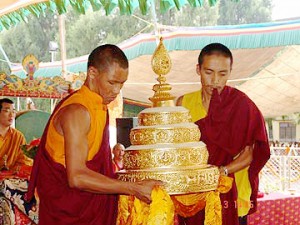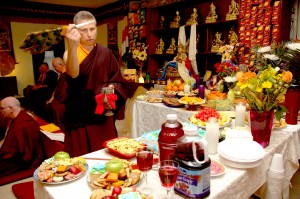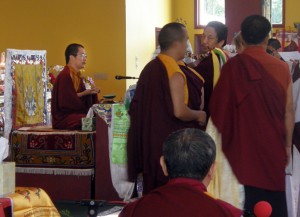An excerpt from the Mindfulness workshop given by Jetsunma Ahkon Lhamo in 1999
Sometimes when we begin to make offerings of what we experience to the Buddhas and Bodhisattvas, we may think it’s not a good idea to offer something that’s not ours, but that’s only because we’re materialists and have this idea of ownership. We really don’t understand how things are. We’re kind of sick and deluded with this idea of the self being the center of all experience. So that being the case, when we offer a tree or a field of flowers that isn’t ours or even offer an experience that you have with someone else that’s wonderful and pleasurable to you or to see a friend of yours that has not one, not two, but three cars — for you to offer any of those things to the Buddhas and the bodhisattvas in your mind, is that illegal because you don’t own them? Of course not. The idea isn’t about ownership. It isn’t about defining that, yet again. It’s about allowing these five senses to participate in Recognition in some way, even if it’s only in a small way. To offer anything that one sees, any image that is formulated in the eyes, any sound – the sound of the beloved’s voice, maybe your beloved friend, your beloved spouse or child – the sound of that voice that is so comforting and so wonderful to us, that very sound can be offered when it meets your ears. Rather than owning it and saying this is about me and my children or me and my spouse or me and my stuff, instead make that kind of ongoing process of offering.
In a very real sense, you’re not so much offering the object as you are offering your response to the object. You’re allowing your senses, your thoughts, and your sensibilities to work in a different way than they have worked before, so then you can feel free. You can offer someone else’s money. You can do anything you want to in that way as long as you are truly sincere and it’s done in a profound way. Remember, we’re keeping in mind the faults of cyclic existence, and practicing that kind of renunciation because we have seen the faults of cyclic existence.
Perhaps you meet somebody really rich, and you may notice, because of the contemplations you’ve been doing on the faults of cyclic existence, that those people are so connected to their money that there is some real clinging going on there. Maybe you notice that that person is all about their money and maybe, because you’ve practiced Recognition, you can see that this is a non-virtue. You can see that this is not making that person happy, that literally the money has no power to make that person happy. So knowing that, in your practice you can visualize that money and offer it to the Buddhas and the bodhisattvas. What good does that do? Does the money disappear out of the banks? No. Perhaps there is some small blessing. Perhaps more importantly, you, by making such an offering and by thinking that way, can begin to differentiate, to distinguish between clinging and some form of Recognition that there is something more precious than our egos. Maybe it’s a baby step, but many of those baby steps make for big movements.
Cultivate the habit of constantly offering everything that you see, all pleasure, and even hardship. When we come into a place in our life where it’s very uncomfortable, where there’s some hardship and we survive and perhaps overcome that hardship, that very event can also be offered. That event can be considered practice, a manifestation of an opportunity to have made offerings, to have been more mindful, and to have been in a better state of Recognition. Then, that very difficulty that you just survived becomes a form of practice. It becomes sacred.
For Westerners, our biggest problem is that lack of a deeper understanding of how to practice. We still think that you go to church on Sunday, and so you practice on Sunday. You do your religious thing on Sunday and maybe on the other holidays. We still have that division in our mind. We are deeply materialistic people, and that is the worst, most horrible delusion that we’re stuck in: that inability to recognize any distinction because of our material outlook. Practicing in the way I’ve described gives us the opportunity to develop constant mindfulness, purification of the mind, and constantly creating new habitual tendencies. It’s perfect for Westerners to practice in this way in addition to their sit-down practice because we have such limited time to sit down. In addition, in this culture we’re taught that when you’re sitting down, you’re being lazy, and our whole commitment, therefore, is to be busy all the time. So one way to begin to counteract that is to practice in this way of constantly making offerings.
© Jetsunma Ahkön Lhamo





